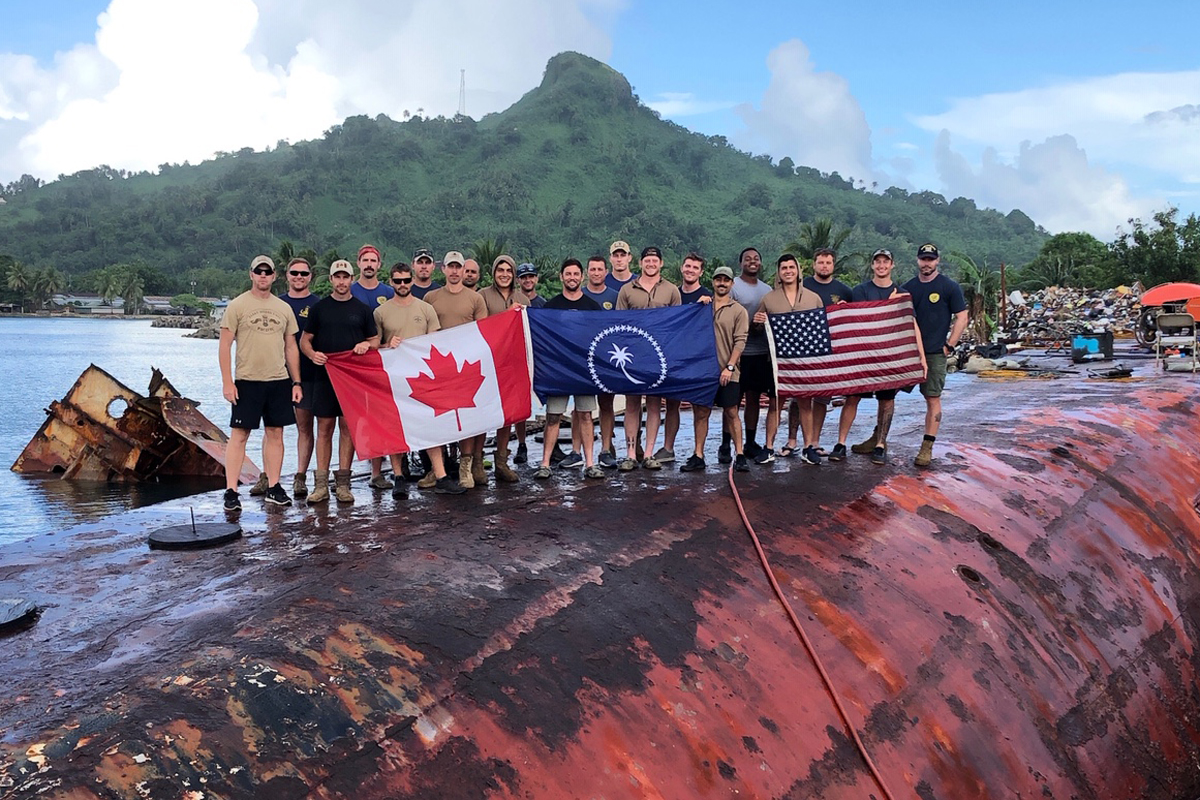Clearance divers assist in Micronesia ship salvage
By Lookout on Feb 26, 2020 with Comments 2

Members of the Fleet Diving Unit (Pacific) and the United States Navy salvage project gather for a team photo on the hull of the MV Micro Dawn in Weno, Chuuk State Federated States of Micronesia. Photo by Lt Byers, MDSU Company 1-3 OIC
Peter Mallett, Staff Writer ~
Four clearance divers from Fleet Diving Unit (Pacific) helped dismantle a sunken commercial vessel of Japanese origin located pier-side in Weno Harbor, Chuuk State, Federated States of Micronesia, capitalizing on a unique training opportunity and a goodwill deed.
The little known Federated States of Micronesia consists of 607 islands extending 2,900 kilometers across the archipelago of the Caroline Islands east of the Philippines. It is an independent republic associated with the United States, who led the salvage project through USN Commander Seventh Fleet.
For a month late last fall, the team of divers assisted the USN Mobile Diving and Salvage Unit (MDSU) ONE with MV Micro Dawn salvage operations, an 869 tonne behemoth cargo ship that sank during a fierce typhoon in 2006.
It settled on its portside, pier-side in Weno Harbour’s only serviceable port terminal restricting access.
The project started last July, with USN divers salvaging it piece by piece, floating salvaged sections to the surface using various lifting bags and subsequently disposing of the sections in deeper water at specific locations approved by the Federated States of Micronesia.
The month’s work by FDU(P) divers was part of MDSU ONE’s year-long effort to clear away the wreckage.
CPO2 Shawn Goodine said his dive team was in uncharted water with the salvage operation of this magnitude. However, due to the high level of training clearance divers receive, and the similarities in USN diving procedures and equipment, his team quickly adjusted and were fully integrated into USN-led diving and salvage operations within days of their arrival in Weno, Chuuk State.
Along with CPO2 Goodine, PO2 Jonathan Gendron, LS Paul Paquette and LS Bryan Ogle worked successfully alongside USN divers. CPO2 Goodine said it was a “seamless” integration with the U.S. counterparts, a testament of the longstanding relationship between FDU(P) – MDSU ONE.
They employed a variety of specialized tools to salvage MV Micro Dawn, including oxy-acetylene torches, below-water welding and cutting torches, exothermic cutting cables, diamond wire saw, and flexible linear shaped explosives. At any given time, 30 navy divers were working simultaneously in various five to six member dive teams on the project.
“During a salvage operation of this magnitude, you really need to remain focused and maintain a sound situational awareness always because there are so many dangerous concurrent activities going on all at once,” said LS Paquette. “There were guys doing acetylene, underwater and above water cutting and many other methods that provided potential danger to everyone involved.”
Dangers were heightened by the climate with peak temperatures of 39° Celsius on the deck of Military Sealift Command Salvage Ship USNS Salvor, and surface water temperatures of 30°C. Heat exhaustion of the divers was a consistent concern, said CPO2 Goodine.
“Any task you performed on the surface is multiplied in effort by four underwater,” said LS Paquette. “Underwater tasks become more onerous and the heat certainly made it a tougher job. Most of the divers easily went through five or six litres of drinking water per day; hydration was essential.”
An unexpected tropical storm suspended diving operations on Dec. 1, but divers were pressed into action when a passenger live-aboard diving charter SS Thorfinn ran aground. The FDU(P) team along with USN and civilian crew members aboard USNS Salvor assisted in the rescue after the storm subsided. They eventually freed the vessel, guiding it and the crew to safe anchorage.
“We were only four miles away from the vessel at the time of the distress call, so it was very lucky for them, but also rewarding for us to be included in the team that assisted these people,” said CPO2 Goodine.
Filed Under: Top Stories
About the Author:






it’s about time. lets clean all shipwrecks in our water before the oils spill out and continue killing our corals.
Thank you!